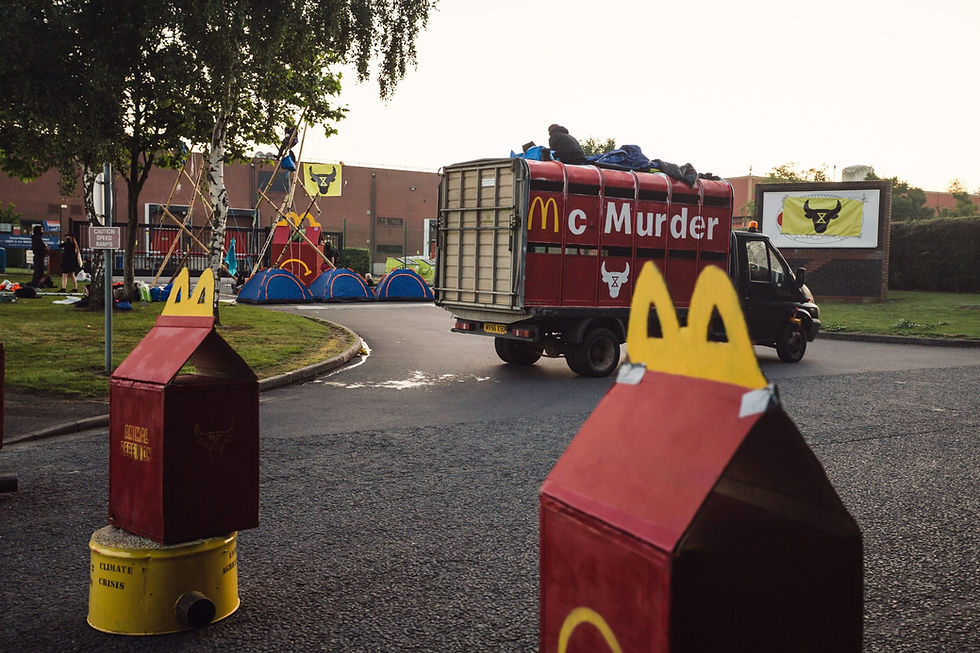In the Performing Animal Rights podcast series, Harley McEckersall, an activist with Animal Rebellion (now Animal Rising), shared fascinating insights into the role of performance within animal rights activism. For Harley, there is an intrinsic link between theatricality and activism—one that shapes how movements communicate, connect, and inspire change.
A Convergence of Performance and Advocacy
Harley’s journey into activism was influenced by a creative upbringing, with a background in theatre and performance. She describes how these two worlds—performance and animal rights—collided naturally, leading her to use art as a way of expressing complex political and ethical issues. For Harley, the power of performance lies in its ability to convey stories and ideas that may be difficult to communicate through conventional means.
As Harley explained, "Art and performance have always been entwined with social struggles." Whether through ancient Greek theatre as a form of political discourse or modern performance art, creativity has played a crucial role in advancing political movements. In the context of animal rights, this power becomes even more significant, as nonhuman animals—unable to communicate in human languages—rely on activists to speak on their behalf. Harley sees performance as a way to bridge this gap, helping to share the experiences of animals and advocate for their rights.
The Power of Symbolism and Theatricality
In the realm of animal rights activism, Harley observes that performance often manifests in symbolic actions. These actions, designed to capture media attention, make use of striking imagery and creative elements to communicate a message. For example, Harley references Animal Rebellion’s blockade of a McDonald’s burger factory, where props like oversized Happy Meal boxes and a giant burger were used to highlight the environmental and ethical issues tied to fast food and factory farming.
This kind of theatricality, according to Harley, is key to gaining public attention. “The more theatrical you are, the more likely you are to be seen,” she notes, emphasising the importance of creating memorable, audacious actions that prompt people to stop and take notice. For Animal Rebellion, targeting brands like McDonald’s wasn’t just about the message—it was also about harnessing the existing “theatre” of the brand to create impactful actions. In this way, activism becomes a performance, where the choice of target, props, and staging all play a role in telling a story that resonates with the public.

Performance as a Tool for Movement Building
While public-facing actions are important, Harley also highlights the role of performance in the internal workings of activism. Performance-based thinking can shape how movements build and organise themselves. Harley draws parallels between movement-building and the concept of “performing” the world we want to see. Activists, she argues, are engaged in an act of performance when they advocate for a new way of relating to animals. By embodying the values of animal rights and social justice, activists perform a vision of a better world—one that doesn’t yet exist but can be realised through collective action.
This idea of “performing the future” is central to Harley’s understanding of activism. For them, performance is not just a tool for creating spectacles, but also a way of envisioning and practicing the change that activists are working towards. “The world we want to see doesn’t exist yet. It needs to be performed until it’s naturalised,” Harley explains. By constantly performing new ways of being and relating, activists can help to shape the cultural and social norms of the future.
The Role of Artists in Social Movements
Throughout history, social movements have often been accompanied by artistic movements that helped to shift public opinion and introduce new ideas. For Harley, this is a crucial component of any movement for change. “Art infiltrates society in ways that campaigns alone cannot,” she states, noting that while activism is important, it is often the creative expressions of these movements—whether through theatre, music, or visual art—that leave a lasting impact on culture.
In the animal rights movement, Harley sees a growing need for more artists to engage with the cause. While there are many effective campaigns within the movement, there is still a lack of mainstream artistic engagement with the issue. As other social justice movements have gained traction through the arts, Harley believes animal rights can benefit from a similar approach, bringing the movement’s message to broader audiences through creative means.
The Challenges of Representation
One of the most difficult challenges in animal rights activism is the representation of nonhuman animals. As Harley points out, there is often debate within the movement about how to represent animals without objectifying or misrepresenting them. Early on, Animal Rebellion faced criticism for using cow costumes to represent actual cows during an anti-dairy campaign. In response, the group shifted its approach, opting for props like painted transport trucks to symbolise the absent animals.
For Harley, this struggle reflects a deeper question about how to visually and creatively represent animals in a way that honours their individuality and experiences. While academic writing on animal rights often provides nuanced representations of nonhuman animals, translating these ideas into visual performance is a challenge. “What is that single image or creative idea that allows us to represent animals without othering them?” Harley asks.
The Future of Performing Animal Rights
As Harley reflected on her work with Animal Rebellion, she acknowledged that the movement has evolved. While the early days were filled with raw creative energy and experimentation, the group found its footing, focusing on actions that had a clear impact. Yet, Harley still sees the potential for more creative exploration within the movement.
Ultimately, Harley believes that performance should be an integral part of the animal rights movement, both as a means of communication and as a way of envisioning the future. Whether through public actions that capture attention or the more subtle performances of day-to-day activism, theatricality remains a powerful tool for inspiring change.
Comentários